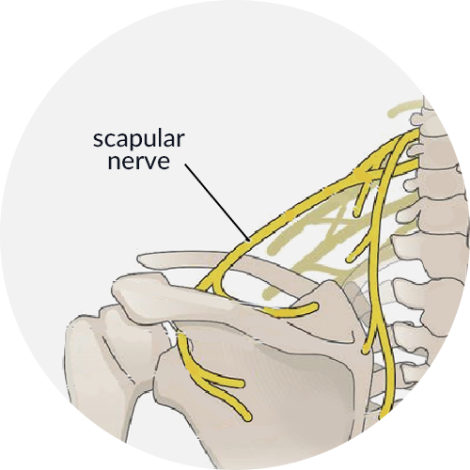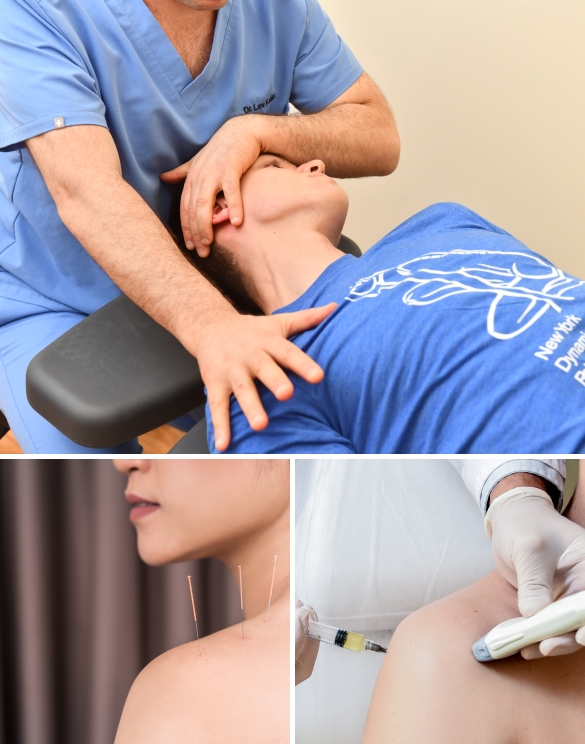The scapula, aka shoulder blade, is the largest bone in the shoulder complex, with 17 muscles attached to it. Some of the tendon-aponeurosis attachments are extremely small, and can only be visualized with ultrasound. In addition, the anatomy of the nerve path from the neck to the shoulder blade is extremely complex, as those nerves pass through the brachial plexus. Because of their minute size and complexity, injuries to the tendons and nerves affecting the scapula often go undiagnosed and undertreated.
or
Dr. Kalika, clinical director of NYDNRehab, has developed his own unique approach to the treatment of shoulder blade pain with the use of high resolution, dynamic ultrasonography. This new and advanced diagnostic technology allows us to clearly visualize the peripheral scapular nerves, tendon-aponeurosis attachments, myofascial trigger points, and fascia ruptures and adhesions. This methodology is relatively new, and requires top-of-the-line equipment, operated by a clinician with extensive skill and experience in diagnostic ultrasonography.
Dr. Kalika is trained and certified in musculoskeletal ultrasonography, and has been using it for over 15 years to accurately diagnose and treat a broad range of conditions that cause pain and dysfunction. By accurately identifying the exact cause of your shoulder blade pain, we are able to quickly begin treatment that brings exceptional results.

Most conventional practitioners zero in on posture as the main cause of shoulder blade pain, and while posture may be a contributing factor, there is often more to the story. To truly get to the bottom of shoulder blade pain, you need to look at the whole person. Once a patient has developed scapular pain and dysfunction, it is nearly impossible to get rid of it with conventional physical therapy and postural correction alone.
Persistent scapular pain that does not respond to conventional treatment is most often caused by compression of the nerves that run from the neck to the shoulder blade, or by lesions to the tendino-aponeurotic tissue that attaches muscles to the scapula. To resolve this type of shoulder blade pain, you need specialized treatment that is rarely found in run-of-the-mill physical therapy clinics.
At NYDNRehab, we use advanced technologies and innovative treatment approaches to diagnose and treat shoulder blade pain. Our unique approach sets us apart as the premier clinic for shoulder blade treatment in NYC.
Pain clustered around the shoulder blade
Knife-like pain near the shoulder blade
Clicking, rubbing or clunking sounds or sensations
Difficulty sleeping on the affected side
Dorsal scapular nerve entrapment
Spinal accessory nerve entrapment
Long thoracic nerve palsy
Intercostal nerve entrapment
Facet syndrome
Thoracic disc herniation
Scapular dyskinesis
Myofascial trigger points
Ruptures and adhesions of the fascia
Gleno-humeral joint instability
Rotator cuff tendinopathy
Cervical spine dysfunction
Our personalized approach to patient care dramatically impacts the accuracy of our diagnosis, setting you up for success from your very first visit. After collecting your medical history and conducting a thorough physical exam, we use the highest resolution diagnostic ultrasound to explore the structures of the shoulder complex.
Our state-of-the-art ultrasonography equipment gives us a window into your scapular region in real time, with the structures in motion. Ultrasound lets us travel the path of nerves to look for entrapments along their path. It also lets us visualize the aponeurotic muscle attachments, to look for lesions that could be the source of your pain.


Once we uncover the underlying mechanisms of your shoulder blade pain and dysfunction, we create a personalized treatment protocol, designed just for you.
Your treatment program may include:
Postural recalibration and retraining
Integrated systems model (ISM) approach to assess how past injuries, faulty movement patterns and posture may be causing pain in your shoulder blade
Ultrasound guided dry needling to release myofascial trigger points
Ultrasound guided injection therapies to promote healing
Regenerative pulse therapies to reduce pain and inflammation, and promote healing
We constantly test and reassess, to monitor your progress and ensure that your treatment protocol is effective.
Regenerative pulse therapies tap into your body’s own innate healing mechanisms to stimulate the progenesis of new cells. Structural damage to the tendons, fascia, nerves and muscles cannot be reversed with physical therapy alone, and patients can sometimes undergo months of physical therapy without making any progress, as pain and structurally degraded tissue cannot regain its function.
Once degenerative changes occur or chronic inflammation sets in, your body may need a jump-start to halt and reverse the degenerative cascade. In much the same way that your body begins to heal a wound with an intricate physiological response, a similar process is set in motion in musculoskeletal tissues in response to regenerative pulse therapies.
The following tips will help you avoid lateral epicondylitis:
Extracorporeal Shock Wave Therapy (ESWT)
Extracorporeal shockwave therapy (ESWT) transmits a series of low-energy acoustic waves to the patient’s skin via a hand-held transducer, with a topical gel as a medium. It is completely non-invasive, and does not require anesthesia or pain medications. Shockwaves trigger the body’s innate healing mechanisms, to stimulate tissue repair and reduce pain. Many patients report significant pain reduction after a single treatment session. According to research, shockwave therapy is considered the gold standard in regenerative medicine.
Extracorporeal Magnetic Transduction Therapy (EMTT)
Electromagnetic transduction therapy (EMTT) uses pulsed electromagnetic fields to halt the degenerative cascade of damaged tissues and promote cellular progenesis. EMTT is non-invasive, delivering electromagnetic waves to the targeted tissues from a device located outside the body. EMTT treatment is comfortable, safe and effective, with no negative side effects. When used in conjunction with ESWT, this new technology works to reduce pain and inflammation and accelerate the healing process.

Chronic pain in the shoulder blade should not be ignored. If left untreated, you could be setting yourself up for injury and dysfunction that undermines your health and diminishes your quality of life.
The shoulder specialists at NYDNRehab leverage the most advanced technologies and therapies to accurately diagnose and treat shoulder blade pain. Our holistic and personalized approach to patient care ensures that every patient gets the most effective shoulder pain treatment available. Contact NYDNRehab today, and start healing so you can get back to doing the things you love.
Dr. Lev Kalika is a world-recognized expert in musculoskeletal medicine. with 20+ years of clinical experience in diagnostic musculoskeletal ultrasonography, rehabilitative sports medicine and conservative orthopedics. In addition to operating his clinical practice in Manhattan, he regularly publishes peer-reviewed research on ultrasound-guided therapies and procedures. He serves as a peer reviewer for Springer Nature.
Dr. Kalika is an esteemed member of multiple professional organizations, including:Independent peer-reviewed research relevant to this treatment approach.
Research authored or co-authored by the clinic’s medical director. The following research publications inform the clinical approach used in this treatment program.